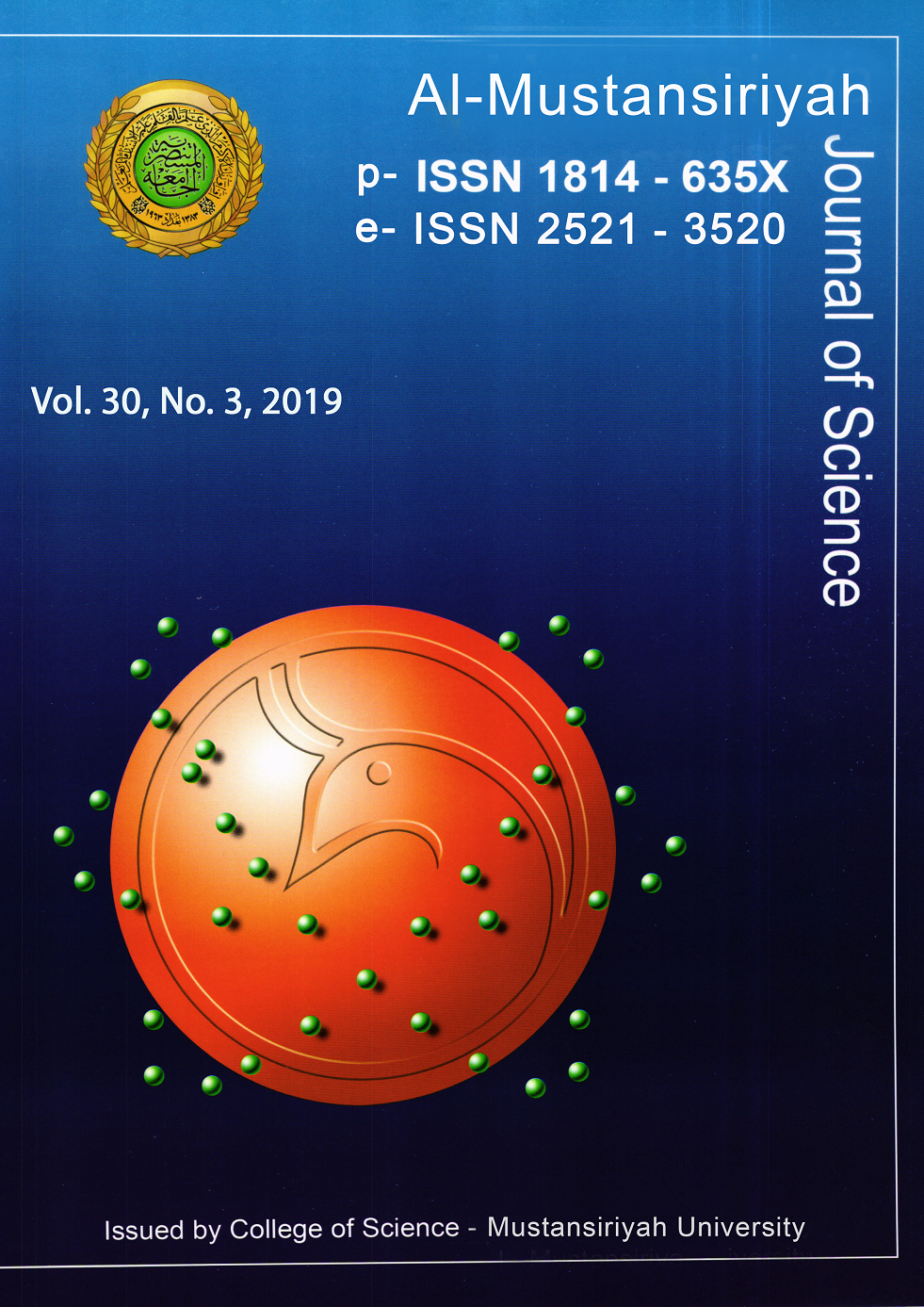Determination and validation of Tetracycline residues in Poultry by High Performance Liquid Chromatography - Diode Array Detector Technique
DOI:
https://doi.org/10.23851/mjs.v30i3.650Keywords:
Tetracycline, HPLC-DAD, Poultry chest, thigh and liver, Validation of analytical Method.Abstract
The aim of this research is separation and determination of trace Tetracycline residues in Poultry chest, thigh and liver using High Performance Liquid Chromatography - Diode Array Detector (HPLC-DAD), with a mobile phase mixture consisting of acetonitrile: methanol: oxalic acid (0.01M) (25:15:60) and chromatographic column C8. The study was done on 32 live poultry individuals. All individuals were injected in the chest by 1m of Tetracycline standard solutions, then slaughter for analysis throughout four successive days. The injection with 10×103 ppb of Tetracycline showed that the traces of Tetracycline residues (according to the Codex Alimentarius Commission) exceeded the value of the maximum residue limit (MRL = 200 ppb) in the thigh and chest meat at the 1st day and the 1st & 2nd days of slay respectively, and exceeded the value of (MRL = 600 ppb) in the liver at the 3rd and 4th days of slay. limit of detection was LOD = 0.451 ppb, limit of quantification LOQ = 1.502 ppb, and recovery percentages of Tetracycline at a concentration of 200.0 ppb for 20 sample Rec.% = (88.966 - 91.055%), (84.623 - 87.667%), (82.198 - 83.688%) for Poultry chest, thigh and liver respectively with a percentage relative standard deviations (RSD%) of < 1 %.Downloads
References
Stolker, A. A. M., Brinkman, U. A. Th., Analytical strategies for residue analysis of veterinary drug and growth-promoting agent in food-producing animals -a review. Journal of Chromatography A., 1067, 15-53, 2005.
Gentili, A., Perret, D., Marchese, S., Liquid chromatography-tandem mass spectrometry for performing confirmatory analysis of veterinary drugs in animal-food products, Trends in Analytical Chemistry, 24(7), 704-733, 2005.
[Crossref]
Atmani, M. S., Messai, Y., Alouache, S., Fernandez, R., Estepa, V., Torres, C., Bakour, R., Virulence characteristics and genetic background of esbl-producing klebsiella pneumoniae isolates from wastewater, Fresenius Environmental Bulletin, 24(1), 103-112, 2015.
Kacar, A., Kocyigit, A., Uluturhan, E., Concentration of heavy metals and investigation of bacterial toxic metal Resistance in coastal city sediments (eastern aegean sea). Fresenius Environmental Bulletin, 25(1), 55-66, 2016.
Jeon, M., Paeng, I. R., Quantitative detection of Tetracycline residues in honey by a simple sensitive immunoassay, Analytica Chimica Acta, 626, 180-185, 2008.
Codex Alimentarius, Commission Maximum Residue Limits for Veterinary Drugs in Foods, Updated at the 35th Session of the Codex, 2012.
Yu, H., Mu, H., Hu, Y-M., Determination of fluoroquinolones, sulfonamides, and Tetracyclines multiresidues simultaneously in porcine tissue by MSPD and HPLC-DAD, Journal of Pharmaceutical Analysis, 2(1), 76-81, 2012.
Taverniers, I., Loose, M. D., Bockstaele, E .V., Trends in quality in the analytical laboratory. II. Analytical method validation and quality assurance, Trends in Analytical Chemistry, 23(8), 535-552. 2004.
[Crossref]
Berrada, H., Borrull, F., Font, G., Moltò, J. C., Marcè, R. M., Validation of a confirmatory method for the determination of macrolides in liver and kidney animal tissues in accordance with the European Union regulation 2002/657/EC, Journal of Chromatography A., 1157, 281-288, 2007.
Cinquina, A. L., Longo, F., Anastasi, G., Giannetti, L., Cozzani, R., Validation of a high-performance liquid chromatography method for the determination of oxyTetracycline, Tetracycline, Chlorotetracycline and doxy-cycline in bovine milk and muscle, Journal of Chromatography A., 987, 227-233, 2003.
[Crossref]
Apostol, I., Miller, K. J., Ratto, J., Kelner, D. N., Comparison of different approaches for evaluation of the detection and quantitation limits of a purity method: a case study using a capillary isoelectrofocusing method for a monoclonal antibody, Analytical Biochemistry, 385(1), 101-106, 2009.
Lee, B. J., Chung, H. H., Lee, G. K. Development of an analytical protocol for detecting antibiotic residues in various foods, Food Chemistry, 105, 1726-1731, 2007.
[Crossref]
Shalaby, A. R., Salama, N. A., Abou-Raya, S. H., Emam, W. H., Mehaya, F. M., Validation of HPLC method for determination of tetracycline residues in chicken meat and liver, Food Chemistry, 124, 1660-1666, 2011.
[Crossref]
Zhai, C. H., Zou, Y., Determination of Tetracyclines in Poultry by Solid-Phase Ex¬traction and High-Performance Liquid Chromatography. Application Note Food Safety. Agilent Technolo¬gies, Inc. 2008, www.agilent.com/chem.
Schneider, J. M., Braden, E. S., Reyes-Herrera, I., Dono- ghue, J. D., Simultaneous determination of fluoroquinolones and Tetracyclines in poultry muscle using HPLC with fluorescence detection, Journal of Chromatography B., 846(1-2), 8-13, 2007.
Downloads
Key Dates
Published
Issue
Section
License
(Starting May 5, 2024) Authors retain copyright and grant the journal right of first publication with the work simultaneously licensed under a Creative Commons Attribution (CC-BY) 4.0 License that allows others to share the work with an acknowledgement of the work’s authorship and initial publication in this journal.






















